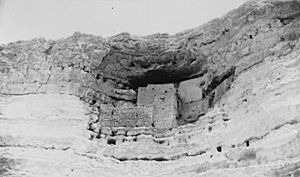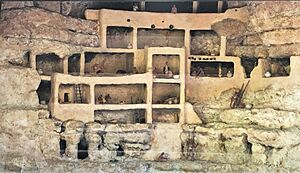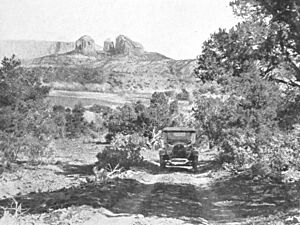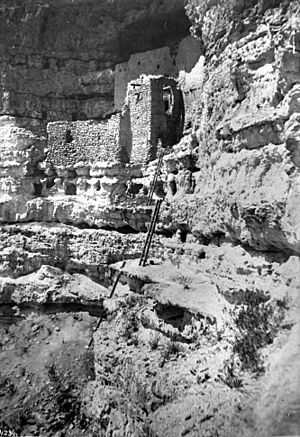Montezuma Castle National Monument facts for kids
Quick facts for kids Montezuma Castle National Monument |
|
|---|---|
|
IUCN Category III (Natural Monument)
|
|
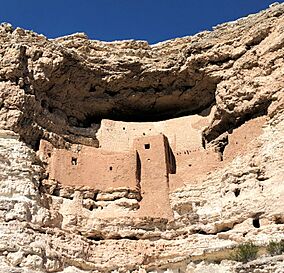
(2021)
|
|
| Location | Yavapai County, Arizona, United States |
| Nearest city | Camp Verde, Arizona |
| Area | 859.27 acres (347.73 ha) |
| Created | December 8, 1906 |
| Visitors | 390,151 (in 2018) |
| Governing body | National Park Service |
| Website | Montezuma Castle National Monument |
| Designated: | October 15, 1966 |
| Reference #: | 66000082 |
Montezuma Castle National Monument is a special place in Camp Verde, Arizona. It protects amazing ancient homes built into a cliff. These homes were made by the Sinagua people, an ancient culture from the southwestern United States.
The Sinagua lived here between about 1100 AD and 1425 AD. The main building is like a five-story apartment complex with about 20 rooms. It took over 300 years to build! Some Hopi and Yavapai communities today are connected to the people who lived in this area long ago.
Contents
What's in a Name?
The name "Montezuma Castle" isn't quite right. When people from Europe first saw these ruins in the 1860s, they thought the famous Aztec emperor Montezuma had built them. But this was a mistake!
The Sinagua people had no connection to the Aztecs. Also, the homes were left empty more than 40 years before Montezuma was even born. It wasn't a "castle" for a king, but more like a tall apartment building from ancient times.
Homes in the Cliff
Montezuma Castle sits about 90 feet (27 meters) up a steep limestone cliff. It faces Beaver Creek, which flows into the Verde River. This is one of the best-preserved cliff homes in North America.
It's so well-preserved because it's tucked into a natural alcove. This spot protects it from bad weather. The Sinagua people were very brave builders and clever engineers to create such a large home so high up!
To get into the building, people likely used portable ladders. This made it hard for enemies to reach them. The main reason the Sinagua built so high was to avoid floods from Beaver Creek. During the summer rainy season, the creek would often overflow.
These floods were good for farming, but they could destroy homes. So, the Sinagua built their permanent homes high in the cliff.
The walls of Montezuma Castle are made of stone and mortar. They used chunks of limestone from the bottom of the cliff. They also used mud and clay from the creek. The ceilings were made of wood from Arizona sycamore trees, which grow in the Verde Valley.
A Look at History
Permanent homes like Montezuma Castle started appearing around 1050 AD. The Sinagua culture might have lived in this area as early as 700 AD.
The area was empty for a short time after a volcano called Sunset Crater Volcano erupted. This happened about 60 miles (97 km) north in the mid-11th century. The eruption might have caused some damage at first. But the ash and dirt from the volcano later helped the soil for farming.
After 1125, the Sinagua people came back to the Verde Valley. They used the Verde River and old irrigation systems to grow more crops. The population probably reached its highest point around 1300 AD. The Castle may have housed 30 to 50 people in its 20 rooms.
Scientists used radiocarbon dating on the wood beams. They found that the cliff dwelling was built in the mid-1100s AD. More rooms and changes were added in the late 1200s. Another large dwelling, called "Castle A," was found nearby in 1933. Only its stone foundations remain.
The Sinagua people left Montezuma Castle around 1425 AD. Other groups in the Southwest also left their homes around that time. We don't know exactly why they left. It could have been because of dry weather, not enough resources, or conflicts with the newly arrived Yavapai people.
Because there was little human contact after it was abandoned, Montezuma Castle stayed well-preserved. However, it was heavily looted in the late 1800s and early 1900s. Today, the monument and the Verde Valley face challenges to keep Montezuma Castle safe.
Plants and Animals
The National Park Service studies the plants and animals in national parks. This helps them understand and protect the environment. From 1991 to 1994, researchers studied Montezuma Castle.
They found about 784 different kinds of plants and animals. This included fish, amphibians, reptiles, birds, and mammals. Only a small number of these species were not native to the area. You might see bats, snakes, turtles, lizards, frogs, foxes, owls, and mice here.
Protecting This Special Place
Montezuma Castle National Monument covers 860 acres in central Arizona. It became a U.S. National Monument on December 8, 1906. This was thanks to the Antiquities Act, a law signed earlier that year.
It was one of the first four National Monuments chosen by President Theodore Roosevelt. The site was also added to the National Register of Historic Places in 1966.
It's easy to visit the monument, just off Interstate 17. There's a paved trail about 1/3 mile (0.5 km) long. It follows the base of the cliff where the ruins are. Since 1951, visitors cannot go inside the ruins. This is to keep people safe and protect the ancient structure.
About 400,000 people visit Montezuma Castle each year. The park is open every day from 8 AM to 5 PM, except for Christmas Day. The visitor center has a museum about the Sinagua culture. You can see tools they used to build their homes. There are also artifacts like stone tools, grinding stones for corn, bone needles, and beautiful ornaments. These show that the Sinagua were skilled artists and traders.
Montezuma Well
Montezuma Well is another interesting place nearby. It's a natural sinkhole in the limestone, about 100 by 120 yards (91 by 110 meters) wide. It also has Sinagua dwellings. The government bought it in 1947, and it's part of Montezuma Castle National Monument. It's about 5 miles (8 km) north of the Castle.
Weather at the Monument
Montezuma Castle National Monument has a cold, dry climate. Winters are cool, and summers can be very hot.
| Climate data for Montezuma Castle National Monument, Arizona, 1991–2020 normals, extremes 1938–present | |||||||||||||
|---|---|---|---|---|---|---|---|---|---|---|---|---|---|
| Month | Jan | Feb | Mar | Apr | May | Jun | Jul | Aug | Sep | Oct | Nov | Dec | Year |
| Record high °F (°C) | 82 (28) |
89 (32) |
96 (36) |
99 (37) |
109 (43) |
117 (47) |
117 (47) |
118 (48) |
111 (44) |
104 (40) |
90 (32) |
78 (26) |
118 (48) |
| Mean maximum °F (°C) | 72.0 (22.2) |
77.1 (25.1) |
85.2 (29.6) |
93.2 (34.0) |
100.3 (37.9) |
108.1 (42.3) |
110.5 (43.6) |
108.0 (42.2) |
102.6 (39.2) |
94.8 (34.9) |
82.5 (28.1) |
71.0 (21.7) |
111.6 (44.2) |
| Mean daily maximum °F (°C) | 60.5 (15.8) |
64.9 (18.3) |
72.0 (22.2) |
79.0 (26.1) |
87.6 (30.9) |
98.1 (36.7) |
100.8 (38.2) |
98.5 (36.9) |
93.0 (33.9) |
82.3 (27.9) |
69.3 (20.7) |
58.6 (14.8) |
80.4 (26.9) |
| Daily mean °F (°C) | 43.2 (6.2) |
47.1 (8.4) |
53.4 (11.9) |
59.5 (15.3) |
67.5 (19.7) |
76.2 (24.6) |
82.4 (28.0) |
80.7 (27.1) |
74.0 (23.3) |
62.5 (16.9) |
50.4 (10.2) |
41.8 (5.4) |
61.6 (16.4) |
| Mean daily minimum °F (°C) | 25.9 (−3.4) |
29.3 (−1.5) |
34.9 (1.6) |
40.0 (4.4) |
47.3 (8.5) |
54.4 (12.4) |
64.0 (17.8) |
62.8 (17.1) |
55.0 (12.8) |
42.6 (5.9) |
31.5 (−0.3) |
25.1 (−3.8) |
42.7 (5.9) |
| Mean minimum °F (°C) | 17.2 (−8.2) |
20.3 (−6.5) |
25.5 (−3.6) |
30.3 (−0.9) |
36.9 (2.7) |
44.2 (6.8) |
54.5 (12.5) |
54.1 (12.3) |
44.7 (7.1) |
32.1 (0.1) |
20.8 (−6.2) |
16.5 (−8.6) |
14.3 (−9.8) |
| Record low °F (°C) | −1 (−18) |
4 (−16) |
12 (−11) |
16 (−9) |
24 (−4) |
36 (2) |
45 (7) |
39 (4) |
31 (−1) |
19 (−7) |
8 (−13) |
4 (−16) |
−1 (−18) |
| Average precipitation inches (mm) | 1.36 (35) |
1.28 (33) |
1.15 (29) |
0.49 (12) |
0.40 (10) |
0.19 (4.8) |
1.52 (39) |
2.13 (54) |
1.49 (38) |
0.95 (24) |
0.71 (18) |
1.50 (38) |
13.17 (335) |
| Average precipitation days (≥ 0.01 inch) | 4.9 | 4.8 | 4.3 | 2.6 | 2.3 | 1.0 | 6.7 | 7.6 | 4.4 | 3.4 | 3.1 | 4.4 | 49.5 |
| Source: NOAA | |||||||||||||
See also
 In Spanish: Monumento nacional Castillo de Montezuma para niños
In Spanish: Monumento nacional Castillo de Montezuma para niños
- List of national monuments of the United States
- List of the oldest buildings in Arizona




